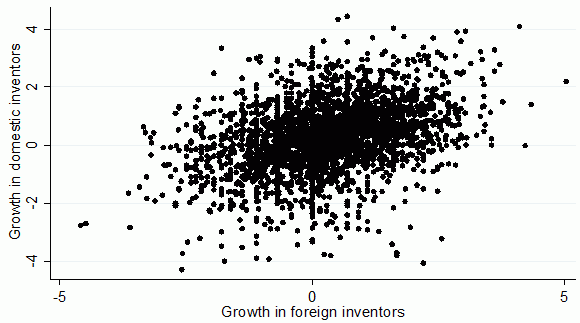It has been well documented that US and European multinationals have expanded the amount of high-tech investment and innovative activities carried out offshore (OECD 2008). There is evidence that firms may offshore innovation activities not only to adapt products to local conditions but also to develop state-of-the-art technology.
A common concern expressed by policymakers and the media is that increasing the amount of innovation conducted offshore, and therefore the number of high-skilled jobs located abroad, may reduce the employment opportunities for high-skilled workers at home (see Freeman 2006, OECD 2007, Economist 2006, BusinessWeek 2007). Similar concerns have been raised in relation to other groups of workers. Indeed, there is a substantial body of evidence showing that foreign competition from low-wage economies can displace low-skilled workers in developed countries (see Braconier and Ekholm 2000, Antràs et al 2006, Harrison and McMillan 2011). The concerns surrounding the offshoring of high-skilled research jobs are particularly acute given that they are associated with the innovations and technological advances that underpin growth in developed economies. High-skilled workers are also intrinsically linked to the important spillovers that arise in the creation of new ideas – researchers embody tacit knowledge that others, often those in close geographical proximity, benefit from. For these reasons, governments are keen to encourage firms to undertake innovative activities in their countries.
It is not obvious what affect an increase in a firm’s employment of high-skilled workers abroad will have on opportunities for high-skilled workers at home and, to date, there has been little empirical evidence in this area.
Consider a firm that employs high-skilled workers both at home and abroad to generate innovations. One possibility is that these workers can be used interchangeably in the production of innovations (ie if they are perfect substitutes); then we would expect an increase in the employment of foreign workers to be at the expense of those at home. Another possibility is that the workers are engaged in different activities and are unrelated in the production of innovation; then the increase offshore may have no effect on activities at home. Put another way, it is not necessarily the case that had activity not been located abroad it would have been conducted in the UK. A final possibility is that the use of foreign high-skilled workers improves the productivity of home workers (ie if they are complements in the production of innovations); then the increase in the employment of foreign high-skilled workers could boost the number of this type of workers employed at home. This would occur, for example, if foreign workers have expertise or knowledge that increases the research capacity or marginal product of home workers. This later possibility is supported by the observation that collaboration among high-skilled workers across countries has become more prominent, and by evidence that there are important benefits to be derived by combining research activities undertaken in different locations (Jones 2009, Wuchty et al 2007, Economist Intelligence Unit 2007).
In recent research we provide new empirical estimates of the impact that increasing the use of inventors (a specific type of high-skilled worker) abroad has on a firm's use of inventors at home (see Abramovsky et al 2012). We use data on the inventors listed on the patent applications of large European multinational firms to investigate this relationship. A simple look at the raw data indicates a positive correlation between the growth in the number of inventors located abroad and growth in the number of inventors based in the home country at the firm-industry level.
Figure 1. Growth of domestic and foreign inventors of EU multinational firms
Note: The vertical and horizontal axes of the figure show normalised growth in domestic and foreign inventors respectively. Foreign inventors are defined as those located outside of a firm’s home country. Each observation is the growth, defined as the log change, in inventors between two consecutive periods (1991–95, 1996–2000, 2001–05) for a parent firm in a specific industry.
Of course, there are many potentially confounding factors that may explain this raw positive correlation; it could arise simply because firms that have experienced positive demand shocks are increasing activity in all locations. We undertake a number of steps to net out these factors and isolate the causal impact of changes in inventors offshore on the domestic use of inventors. For our main result we exploit the fact that we observe firms operating in multiple industries and, within industries, in multiple countries. We can therefore use differential changes in the pattern of location of inventors within firms across industries to control for firm-level shocks. We also implement a strategy to net out firm industry–specific factors that may affect the use of inventors in all locations. Taken together our results suggest that we cannot rule out the possibility that foreign inventors displace home inventors, but our main result suggests that a 10% increase in the number of inventors abroad results in a 1.9% increase in the number of inventors at home. That is, we find evidence that those firms that increase the number of inventors they employ offshore tend to also increase the number employed at home.
This result has an interesting policy implication. It suggests that the challenges for governments in developed countries relate not to devising policies to deter offshore investment in innovative activities, but to ensuring that investment at home is sufficient to foster a high-skilled workforce that can engage, both competitively and collaboratively, in creating new knowledge and that is flexible enough to adjust to changing economic conditions.
References
Abramovsky, L, R Griffith, and H Miller (2012), “Offshoring high-skilled jobs: EU multinationals and domestic employment of inventors”, CEPR Discussion Paper No. 8837.
Antràs, P, L Garicano, and E Rossi-Hansberg (2006), “Offshoring in a knowledge economy”, Quarterly Journal of Economics, MIT Press, 121(1):31–77, 02.
Braconier, H and K Ekholm (2000), “Swedish Multinationals and Competition from High- and Low-Wage Locations”, Review of International Economics, 8(3):448–61.
Business Week (2007), “How to keep your job onshore”, 20 August.
Economist (2006), “Nightmare scenarios”, 5 October (last accessed 29 November 2011).
Harrison, AE and MS McMillan (2011), “Offshoring Jobs? Multinationals and US Manufacturing Employment”, Review of Economics and Statistics, 93(3):857–75.
Economist Intelligence Unit (2007), “Sharing the idea. The emergence of global innovation networks”.
Freeman, R (2006), “Does Globalization of the Scientific/Engineering Workforce Threaten US Economic Leadership”, in Jaffe, Lerner and Stern (eds.), Innovation Policy and the Economy, Vol 6, MIT Press
Jones, B (2009), "The Burden of Knowledge and the `Death of the Renaissance Man': Is Innovation Getting Harder?", Review of Economic Studies, 76:283–317.
OECD (2008), “The Internationalisation of Business R&D. Evidence, Impacts and Implications”, OECD Publishing, ISBN-978-92-64-04404-3
OECD (2007), "Offshoring and Employment: Trends and Impacts”, OECD Publishing, ISBN: 978-92-64-03092-3
Wuchty, S, B Jones, and B Uzzi (2007), "The increasing dominance of teams in production of knowledge", Science, 18 May.




